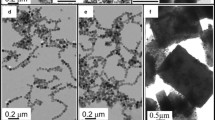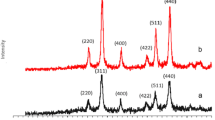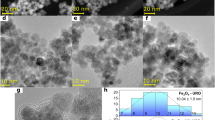Abstract
In this work, the study of aqueous media co-precipitation-obtained magnetite nanoparticles (Fe3O4-NPs) and Rhodamine 6G coating nanoparticles: Fe3O4/Rh6G-NPs, stabilized with polyethylene glycol is presented. To assess their suitability for magnetic hyperthermia application, cellular internalization of Fe3O4/Rh6G nanoparticles using the fungus Neurospora crassa as a model system was also explored. The structural characterization by Infrared and Raman spectroscopies, as well as Transmission Electron Microscopy (TEM) of this material showed that the Fe3O4/Rh6G-NPs are chemically stable with a pure crystalline phase, exhibiting an average particle size of 38.6 ± 6.4 nm and a near-spherical shape; all these properties are desired for nanoparticles that are intended to be used in biomedical applications. Additionally, a marked superparamagnetic behavior in the composite was revealed by the magnetic characterization. The living cells exposed to Fe3O4/Rh6G-NPs showed fluorescence from the apical dome to the basal zone of the hyphae scanned under confocal microscopy; while TEM observations of ultrathin sections demonstrated the presence of Fe3O4/Rh6G-NPs throughout the cytoplasm of the fungus, corroborating internalization of the nanocomposite. It is worth mentioning that alteration of fungus growth or cell morphology after exposure to Fe3O4/Rh6G-NPs were not observed, which represent an important precedent of internalization of inorganic materials-based nanocomposites in cells for further exploration of magnetic hyperthermia applications.






Similar content being viewed by others
References
Alvarez-Berríos MP, Sosa-Cintron N, Rodriguez-Lugo M et al (2016) Hybrid nanomaterials based on iron oxide nanoparticles and mesoporous silica nanoparticles: overcoming challenges in current cancer treatments. J Chem 2016:2–5. https://doi.org/10.1155/2016\/2672740
Balaev DA, Semenov SV, Dubrovskiy AA et al (2017) Superparamagnetic blocking of an ensamble of magnetite nanoparticles upon interparticle interactions. J Magn Magn Mater 440:199–202. https://doi.org/10.1016/j.jmmm.2016.12.046
Bañobre-López M, Teijeiro A, Rivas J (2013) Magnetic nanoparticle-based hyperthermia for cancer treatment. Rep Pract Oncol Radiother 18:398. https://doi.org/10.1016/j.rpor.2013.09.011
Barzan M, Hajiesmaeilbaigi F (2016) Effect of gold nanoparticles on the optical properties of Rhodamine 6G. Eur Phys J D 70:121. https://doi.org/10.1140/epjd/e2016-70088-6
Beik J, Abed Z, Ghoreishi FS et al (2016) Nanotechnology in hyperthermia cancer treatment: from fundamental principles to advanced applications. J Control Release 235:206. https://doi.org/10.1016/j.jconrel.2016.05.062
Bhandari R, Gupta P, Dziubla T et al (2016) Single step synthesis, characterization and applications of curcumin functionalized iron oxide magnetic nanoparticles. Mater Sci Eng C 67:59–64. https://doi.org/10.1016/j.msec.2016.04.093
Carvalho MH, Lima RJS, Meneses CT et al (2016) Determination of the effective anisotropy constant of CoFe2O4 nanoparticles through the T-dependence of the coercive field. J Appl Phys 119:093909. https://doi.org/10.1063/1.4942535
Castro-Longoria E, Vilchis-Nestor AR, Avalos-Borja M (2011) Biosynthesis of silver, gold and bimetallic nanoparticles using the filamentous fungus Neurospora crassa. Colloids Surf B 83:42–48. https://doi.org/10.1016/j.colsurfb.2010.10.035
Chen L, Wu Y, Wu H et al (2019) Magnetic targeting combined with active targeting of dual-ligand iron oxide nanoprobes to promote the penetration depth in tumors for effective magnetic resonance imaging and hyperthermia. Acta Biomater 96:491–504. https://doi.org/10.1016/j.actbio.2019.07.017
Cheraghipour E, Tamaddon AM, Javadpour S et al (2013) PEG conjugated citrate-capped magnetite nanoparticles for biomedical applications. J Magn Magn Mater 328:91–95. https://doi.org/10.1016/j.jmmm.2012.09.042
Chesnel K, Trevino M, Cai Y et al (2014) Particle size effects on the magnetic behavior of 5 to 11 nm Fe3O4 nanoparticles coated with oleic acid. J Phys Conf Ser 521:012004. https://doi.org/10.1088/1742-6596/521/1/012004
Chicheł A, Skowronek J, Kubaszewska M et al (2007) Hyperthermia – description of a method and a review of clinical applications. Rep Pract Oncol Radiother 12:272. https://doi.org/10.1016/S1507-1367(10)60065-X
Chukanov NV (2014) Infrared spectra of mineral species, vol. 1. Springer, Dordrecht, p 285 (Chapter 7)
Cornell RM, Schwertmann U (2003) The iron oxides: structure, properties, reactions, occurences and uses. WILEY-VCH Verlag GmbH & Co KGaA, Weinheim, pp 139–183 (Chapter 7)
Cullity BD, Graham CD (2009) Introduction to magnetic materials, 2nd edn. Wiley, Hoboken
de Faria DLA, Venâncio-Silva S, de Oliveira MT (1997) Raman microspectroscopy of some iron oxides and oxyhydroxides. J Raman Spectrosc 28:873–878
Deatsch AE, Evans BA (2014) Heating efficiency in magnetic nanoparticle hyperthermia. J Magn Magn Mater 354:163. https://doi.org/10.1016/j.jmmm.2013.11.006
Deng H, Yu H (2018) Self-assembly of rhodamine 6G on silver nanoparticles. Chem Phys Lett 692:75–80. https://doi.org/10.1016/j.cplett.2017.12.003
Dutz S, Hergt R (2014) Magnetic particle hyperthermia—a promising tumour therapy? Nanotechnology 25(2014):1–2. https://doi.org/10.1088/0957-4484/25/45/452001
Elahi N, Rizwan M (2021) Progress and prospects of magnetic iron oxide nanoparticles in biomedical applications: a review. Artif Organs 45:1272–1299. https://doi.org/10.1111/aor.14027
Ferreti AM, Usseglio S, Mondini S et al (2021) Towards bio-compatible magnetic nanoparticles: immune-relatedeffects, in-vitro internalization, and in-vivo bio-distribution of zwitterionic ferrite nanoparticles with unexpected renal clearance. J Colloid Interface Sci 582:678–700. https://doi.org/10.1016/j.jcis.2020.08.026
Figueroa AI (2015) Magnetic nanoparticles: a study by synchrotron radiation and RF transverse susceptibility. Springer Thesis. Springer, New York, pp 49–59
Freeman ML, Henle KJ, Dewhirst MW (1997) Hyperthermia. Encyclopedia of cancer. Elsevier Science, USA, pp 447–459
Gahrouei ZE, Imani M, Soltani M, Shafyei A (2020) Synthesis of iron oxide nanoparticles for hyperthermia application: effect of ultrasonic irradiation assisted co-precipitation route. Adv Nat Sci Nanosci Nanotechnol 11:025001. https://doi.org/10.1088/2043-6254/ab878f
Gittleman JL, Abels B, Rozowski S (1974) Superparamagnetism and relaxation effects in granular Ni-SiO2 and Ni-Al2O3 films. Phys Rev B 9–9:3891. https://doi.org/10.1103/PhysRevB.9.3891
Hansen MF, Mørup S (1999) Estimation of blocking temperatures from ZFC/FC curves. J Magn Magn Mater 203:214–216. https://doi.org/10.1016/S0304-8853(99)00238-3
Hauser AK, Mitov MI, Daley EF et al (2016) Targeted iron oxide nanoparticles for the enhancement of radiation therapy. Biomaterials 105:127–135. https://doi.org/10.1016/j.biomaterials.2016.07.032
Hergt R, Dutz S, Müller R et al (2016) Magnetic particle hyperthermia: nanoparticle magnetism and material development for cancer therapy. J Phys Condens Matter 18:2920. https://doi.org/10.1088/0953-8984/18/38/S26
Hickey PC, Swift SR, Roca MG et al (2005) Live-cell imaging of filamentous fungi using vital fluorescent dyes and confocal microscopy. Methods Microbiol 34:63–87. https://doi.org/10.1016/S0580-9517(04)34003-1
Hou Y, Yu J, Gao S (2003) Solvothermal reduction synthesis and characterization of superparamagnetic magnetite nanoparticles. J Mater Chem 13:1983–1987. https://doi.org/10.1039/B305526D
Illés E, Szekeres M, Kupcsik E et al (2014) PEGylation of surfacted magnetite core–shell nanoparticles for biomedical application. Colloids and Surfaces A: physicochem. Eng Aspects 460:429–440. https://doi.org/10.1016/j.colsurfa.2014.01.043
Illés E, Tombácz E, Szekeres M et al (2015) Novel carboxylated PEG-coating on magnetite nanoparticles designed for biomedical applications. J Magn Magn Mater 380:132–139. https://doi.org/10.1016/j.jmmm.2014.10.146
Iszály Z, Márián IG, Szabó IA et al (2022) Theory of superlocalized magnetic nanoparticle hyperthermia: rotating versus oscillating fields. J Magn Magn Mater 541:168528. https://doi.org/10.1016/j.jmmm.2021.168528
Janani V, Induja S, Jaison D et al (2021) Tailoring the hyperthermia potential of magnetite nanoparticles via gadolinium ION substitution. Ceram Int 47:31399–31406. https://doi.org/10.1016/j.ceramint.2021.08.015
Jiang ZL, Zhou SM, Liang AH et al (2006) Resonance Scattering Effect of rhodamine dye association nanoparticles and its application to respective determination of trace ClO2 and Cl2. Environ Sci Technol 40:4286–4291. https://doi.org/10.1021/es051949u
Karimzadeh I, Dizaji HR, Aghazadeh M (2016) Development of a facile and effective electrochemical strategy for preparation of iron oxides (Fe3O4 and γ-Fe2O3) nanoparticles from aqueous and ethanol mediums and in situ PVC coating of Fe3O4 superparamagnetic nanoparticles for biomedical applications. J Magn Magn Mater 416:81–88. https://doi.org/10.1016/j.jmmm.2016.05.015
Khurshid H, Lampen-Kelley P, Iglesias O et al (2015) Spin-glass-like feezing of inner and outer surfaces layers in hallow γ-Fe2O3 nanoparticles. Sci Rep 5:15054. https://doi.org/10.1038/srep15054
Krahne R, Morello G, Figuerola A et al (2011) Physical properties of elongated inorganic nanoparticles. Phys Rep 501:75–221. https://doi.org/10.1016/j.physrep.2011.01.001
Laurent S, Forge D, Port M (2008) Magnetic iron oxide nanoparticles: synthesis, stabilization, vectorization, physicochemical characterizations, and biological applications. Chem Rev 108:2064–2110. https://doi.org/10.1021/cr068445e
Laurent S, Dutz S, Häfeli UO et al (2011) Magnetic fluid hyperthermia: focus on superparamagnetic iron oxide nanoparticles. Adv Coll Interface Sci 166:8–9. https://doi.org/10.1016/j.cis.2011.04.003
Li G, Zhang K, Pei Z et al (2019) A novel method to enhance magnetic property of bioactive glass-ceramics for hyperthermia. Ceram Int 45:4945–4956. https://doi.org/10.1016/j.ceramint.2018.11.194
Lichius A, Berepiki A, Read ND (2011) Form follows function—the versatile fungal cytoskeleton. Fungal Biol 115:518–540. https://doi.org/10.1016/j.funbio.2011.02.014
Liu KC, Chen TM (2021) Comparative study of heat transfer and thermal damage assessment models for hyperthermia treatment. J Therm Biol 98:102907. https://doi.org/10.1016/j.jtherbio.2021.102907
Livesey KL, Ruta S, Andersen NR et al (2018) Beyond the blocking model to fit nanoparticles ZFC/FC magnetization curves. Sci Rep 8:11166. https://doi.org/10.1038/s41598-018-29501-8
Mandal-Goswami M, Dey C, Bandyopadhyay A et al (2016) Micelles driven magnetite (Fe3O4) hollow spheres and a study on AC magnetic properties for hyperthermia application. J Magn Magn Mater 417:376–381. https://doi.org/10.1016/j.jmmm.2016.05.069
Mantilla J, León-Félix L, Martinez MAR, Souza P, Rodrigues PAM, Figueiredo LC, da Silva SW, Coaquira JAH, Aragón FFH, Morais PC (2019) Evidence of surface spin-glass behavior in NiFe2O4 nanoparticles determined using magnetic resonance technique. J Magn Magn Mater 476:392–397. https://doi.org/10.1016/j.jmmm.2019.01.001
Martín V, Bañuelos J, Enciso E et al (2011) Photophysical and lasing properties of rhodamine 6G confined in polymeric nanoparticles. J Phys Chem C 115:3926–3933. https://doi.org/10.1021/jp1108575
Martínez-Cabanas M, López-García M, Barriada JL et al (2016) Green synthesis of iron oxide nanoparticles. Development of magnetic hybrid materials for efficient As(V) removal. Chem Eng J 301:83–91. https://doi.org/10.1016/j.cej.2016.04.149
Martínez-Martínez V, López-Arbeloa F (2007) Fotorrespuesta de colorantes fluorescentes intercalados en películas ordenadas de arcillas. Anales De Química 103:5–13
Mohammadi H, Nekobahr E, Akhtari J et al (2021) Synthesis and characterization of magnetite nanoparticles by co-precipitation method coated with biocompatible compounds and evaluation of in-vitro cytotoxicity. Toxicol Rep 8:331–336. https://doi.org/10.1016/j.toxrep.2021.01.012
Nayek C, Manna K, Bhattacharjee G et al (2017) Investigating size- and temperature-dependent coercivity and saturation magnetization in PEG coated Fe3O4 nanoparticles. Magnetochemistry 3:19. https://doi.org/10.3390/magnetochemistry3020019
Nie S, **ng Y, Kim GJ, Simons JW (2007) Nanotechnology applications in cancer. Annu Rev Biomed Eng 9:257–288. https://doi.org/10.1146/annurev.bioeng.9.060906.152025
Nikiforov VN, Ignatenko AN, Irhin YV (2014) Magnetism of magnetite nanoparticles: effects of finite size and coating. Bull Russ Acad Sci Phys 78:10. https://doi.org/10.3103/S1062873814100153
Nuzhina JV, Shtil AA, Prilepskii AY et al (2019) Preclinical evaluation and clinical translation of magnetite-based nanomedicines. J Drug Deliv Sci Technol 54:101282. https://doi.org/10.1016/j.jddst.2019.101282
Patil RM, Thorat ND, Shete PB et al (2016) In vitro hyperthermia with improved colloidal stability and enhanced SAR of magnetic core/shell nanostructures. Mater Sci Eng C 59:702–709. https://doi.org/10.1016/j.msec.2015.10.064
Peddis D, Cannas C, Musinu A, Piccaluga G (2008) Coexistence of superparmagnetism and spin-glass like magnetic ordering phenomena in a CoFe2O4-SiO2 nanocomposite. J Phys Chem C 112:5141–5147. https://doi.org/10.1021/jp076704d
Peiravi M, Eslami H, Ansari M et al (2021) Magnetic hyperthermia: potentials and limitations. J Indian Chem Soc 2021:100269. https://doi.org/10.1016/j.jics.2021.100269
Perecin CJ, Tirich BM, Nagamine L et al (2021) Aqueous synthesis of magnetite nanoparticles for magnetic hyperthermia: formation mechanism approach, high water-dispersity and stability. Colloids Surf A 627:127169. https://doi.org/10.1016/j.colsurfa.2021.127169
Petcharoen K, Sirivat A (2012) Synthesis and characterization of magnetite nanoparticles via the chemical co-precipitation method. Mater Sci Eng B 177:421–427. https://doi.org/10.1016/j.mseb.2012.01.003
Pušnik K, Goršak T, Drofenik M et al (2016) Synthesis of aqueous suspensions of magnetic nanoparticles with the co-precipitation of iron ions in the presence of aspartic acid. J Magn Magn Mater 413:65–75. https://doi.org/10.1016/j.jmmm.2016.04.032
Ren MX, Wang YQ, Lei BY et al (2021) Magnetite nanoparticles anchored on graphene oxide loaded with doxorubicin hydrochloride for magnetic hyperthermia therapy. Ceram Int 47:20686–20692. https://doi.org/10.1016/j.ceramint.2021.04.080
Riquelme M, Yarden O, Bartnicki-Garcia S et al (2011) Architecture and development of the Neurospora crassa hypha- a model cell for polarized growth. Fungal Biol 115:446–474. https://doi.org/10.1016/j.funbio.2011.02.008
Rodovalho FL, Capistrano G, Gomes JA et al (2016) Elaboration of magneto-thermally recyclable nanosorbents for remote removal of toluene in contaminated water using magnetic hyperthermia. Chem Eng J 302:725–732. https://doi.org/10.1016/j.cej.2016.05.110
Sahoo SK, Parveen S, Panda JJ (2007) The present and future of nanotechnology in human health care. Nanomed Nanotechnol Biol Med 3:20–31. https://doi.org/10.1016/j.nano.2006.11.008
Satoshi Ota S, Trisnanto SB, Takeuchi S et al (2021) Quantitation method of loss powers using commercial magnetic nanoparticles based on superparamagnetic behavior influenced by anisotropy for hyperthermia. J Magn Magn Mater 538:168313. https://doi.org/10.1016/j.jmmm.2021.168313
Shah RR, Davis TP, Glover AL et al (2015) Impact of magnetic field parameters and iron oxide nanoparticle properties on heat generation for use in magnetic hyperthermia. J Magn Magn Mater 387:96. https://doi.org/10.1016/j.jmmm.2015.03.085
Shebanova ON (2003) Lazor P Raman spectroscopic study of magnetite (FeFe2O4): a new assignment for the vibrational spectrum. J Solid State Chem 174:424–430. https://doi.org/10.1016/S0022-4596(03)00294-9
Shen L, Qiao Y, Guo Y et al (2014) Facile co-precipitation synthesis of shape-controlled magnetite nanoparticles. Ceram Int 40:1519–1524. https://doi.org/10.1016/j.ceramint.2013.07.037
Silva AH, Lima E Jr, Vasquez-Mansilla M et al (2016) Superparamagnetic iron-oxide nanoparticles mPEG350– and mPEG2000-coated: cell uptake and biocompatibility evaluation. Nanomed Nanotechnol Biol Med 12:909–919. https://doi.org/10.1016/j.nano.2015.12.371
Soares P, Machado D, Laia C et al (2016) Thermal and magnetic properties of chitosan-iron oxide nanoparticles. Carbohyd Polym 149:382–390. https://doi.org/10.1016/j.carbpol.2016.04.123
Spurr AR (1969) A low-viscosity epoxy resin embedding medium for electron microscopy. J Ultrastruct Res 26:31–43. https://doi.org/10.1016/S0022-5320(69)90033-1
Suppiah DD, Abd-Hamid SB (2016) One step facile synthesis of ferromagnetic magnetite nanoparticles. J Magn Magn Mater 414:204–208. https://doi.org/10.1016/j.jmmm.2016.04.072
Šutka A, Lagzdina S, Juhnevica I et al (2014) Precipitation synthesis of magnetite Fe3O4 nanoflakes. Ceram Int 40:11437–11440. https://doi.org/10.1016/j.ceramint.2014.03.140
Suto M, Hirota Y, Mamiya H et al (2009) Heat dissipation mechanism of magnetite nanoparticles in magnetic fluid hyperthermia. J Magn Magn Mater 321:1493–1494. https://doi.org/10.1016/j.jmmm.2009.02.070
Tang Y, Flesch R, ** T et al (2021) Computational evaluation of malignant tissue apoptosis in magnetic hyperthermia considering intratumoral injection strategy. Int J Heat Mass Transf 178:121609. https://doi.org/10.1016/j.ijheatmasstransfer.2021.121609
The-Nguyen D, Kim K (2016) Controlled synthesis of monodisperse magnetite nanoparticles for hyperthermia-based treatments. Powder Technol 301:1112–1118. https://doi.org/10.1016/j.powtec.2016.07.052
Urian YA, Atoche-Medrano JJ, Quispe LT, León Félix L, Coaquira JAH (2021) Study of the surface properties and particle-particle interactions in oleic acid-coated Fe3O4 nanoparticles. J Magn Magn Mater 525:167686. https://doi.org/10.1016/j.jmmm.2020.167686
Vogel HJ (1956) A convenient growth medium for Neurospora crassa. Microbial Genetics Bull 13:42–47
Yazdani F, Fattahi B, Azizi N (2016) Synthesis of functionalized magnetite nanoparticles to use as liver targeting MRI contrast agent. J Magn Magn Mater 406:207–211. https://doi.org/10.1016/j.jmmm.2016.01.026
Zhang Q, Li D, Cui WB, Li J, Zhang ZD (2009) Magnetic properties and spin-glass-like behavior in stoichiometric Mn3In compound. J Appl Phys 106:113915. https://doi.org/10.1063/1.3266016
Zhu L, Pan D, Ding L (2010) Mixed hemimicelles SPE based on CTAB-coated Fe3O4/SiO2 NPs for the determination of herbal bioactive constituents from biological samples. Talanta 80:1873–1880. https://doi.org/10.1016/j.talanta.2009.10.037
Acknowledgements
This work was supported by CONACYT [Grant numbers 280518 and A1-S-34533]. The authors thank Sc.M. Lizbeth Triana (CCIQS) for technical assistance with IR spectroscopy.
Author information
Authors and Affiliations
Corresponding author
Ethics declarations
Conflict of interest
On behalf of all authors, the corresponding author states that there is no conflict of interest.
Additional information
Publisher's Note
Springer Nature remains neutral with regard to jurisdictional claims in published maps and institutional affiliations.
Supplementary Information
Below is the link to the electronic supplementary material.
Supplementary file1 (MP4 7995 KB)
Rights and permissions
About this article
Cite this article
Hernández-Guerrero, N., Castro-Longoria, E., Torres-Gómez, N. et al. Magnetite/Rhodamine 6G nanoparticles internalization in Neurospora crassa cells: towards the magnetic hyperthermia application. Appl Nanosci 12, 1791–1802 (2022). https://doi.org/10.1007/s13204-021-02317-1
Received:
Accepted:
Published:
Issue Date:
DOI: https://doi.org/10.1007/s13204-021-02317-1




